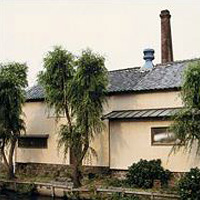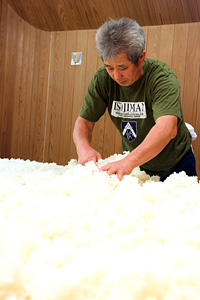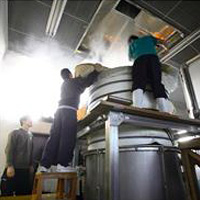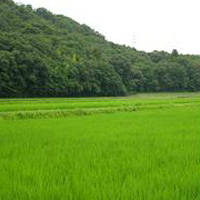

Isojiman Shuzo was established in Yaizu City, Shizuoka Prefecture in 1830 (Tenpo Era, First year).
Like many sake breweries established in Edo Period, the owner of Isojiman Shuzo was a major landowner in Yaizu, and possibly the village headman. In those days, major landowners as village heads would use their land for the collection and transport of the annual rice tax, and use the rice tax as payment for wages to the samurais and circulated rice distribution in market. In the process, it was common for surplus rice to emerge, and be used to produce sake of high commercial value.
In other words, the major landowners and village heads would engage in farm management as theirmain business, and then brew sake during the agricultural off-season in winter. However, this management form ended with the farmland liberation policy carried out by the postwar GHQ, and sake brewing as a secondary job became the principal occupation. In those days, there were many small breweries, as many as one brewery for one village. However, they were consolidated under the guidance of the Finance Ministry at the time.
After the postwar confusion, Japan entered into a period of high economic growth. While younger generations of Japanese are only familiar with Japan after the burst of the “bubble”, Japan’s economy soared for a long time after the war. In those days, sake consumption continued to increase as if linked to the economy so that even major manufacturers would say “Sake production can’t keep up with consumption.” “Vat purchasing” system was invented where major manufactures could purchase and blend whole vats of sake brewed by local sake breweries, add sugars and adjust the taste, and then sell the sake under their own brands. This system was advantageous for the local sake breweries. The breweries only needed to brew the sake and the major manufacturers would buy them. The brewery did not need to carry out reserch to improve quality, or marketing efforts such as advertising. With the exception of a few famous local sake breweries, most local breweries heavily relied on vat purchasing. These conditions continued for a long time.

Sake consumption increased alongside the postwar economy growth. However, the economic “bubble” period began near the end of the Showa period, and a decreasing trend gradually appeared. A decrease in import tariffs on alcoholic beverages caused an explosion in the variety of alcoholic beverages, leading to the popularity of “fashionable alcohol,” such as bourbon, wine, and cocktails, especially among people in their 20’s and 30’s. The change in food selection mainly in urban areas, as more restaurants served French or Italian cuisine, is thought to have contributed to this. Amid an escalating trend of expensive/authentic drinks within the economic “bubble” climate, sake completely missed out and became an “old-fashioned alcoholic beverage.” Sensing this coming crisis early, Isojiman thought “In the coming generation, we won’t survive unless we’ll work toward high-quality sake.” The president of Isojiman smiles, “Around 1975, my father (president at the time, currently chairman) and I talked about and decided to brew good, high-quality sake. If we had not made that decision, the brewery, Isojiman would not exist today.”The “Toji” (Master Sake Brewer) of Isojiman at the time was Fukushi Yokoyama, a Shida Toji (Shida Sake Master Brewer). Yokoyama worked hard to lay the foundation for the current quality of Isojiman until his retirement at the age of 75, and devoted himself in training his successors and passing on the quality of Isojiman.
Today, Nobuo Tada, a Nambu “Toji”, has inherited the quality of Isojiman Shuzo. His exquisite and profound “koji” making technology is recognized as a consummate skill by those in the field. Many young brewers struggle under the direction of Master Tada. From veteran to apprentice, the spirit (the artisan spirit) to carefully protect the quality is passed on. This is a major advantage of Isojiman Shuzo.

The efforts and ideas of IsojimanShuzo can be summed up by, “Do not betray the trust of the liquor shops and sake fans.” “Conditions for sake brewing always vary.” The quality and characteristics of the harvested rice change each year, and temperature and humidity change from year to year and day to day. Furthermore, the same conditions cannot be repeated in sake brewing, because sake is made from living things such as “koji (mold) and yeast. Under such ever-changing conditions, we are always considering ways to maintain and repeat the quality of Isojiman, as expected and trusted by our customers. We do not spare efforts to adopt any new technology or invest in different equipment. We believe that unsparingly working a little harder, no matter how tired, is what is important in sake brewing.”
As many people know, the inside of Isojiman Shuzo’s brewery storehouse is like a refrigerator, covered with stainless steel, and a clean environment is constantly maintained. In Yaizu, there are rows of refrigerated and cold storage warehouses. This technology was applied to Isojiman Shuzo.
The company president himself invented and designed the brewing facility in order to stably maintain and repeat the “quality of Isojiman.” Many brewing devices have been adopted exclusively for Isojiman Shuzo in Shizuoka Prefecture.
Company president Teraoka is infatuated with Yamada Nishiki, sake rice grown in Tojo Town (current Kato City), Hyogo Prefecture. Yamada Nishiki is called the “King of Sake Rice” and Tojo Town is one of the few top production areas called a Special A Area. Not surprising, the rice is rare farmers. It took 6 years before he could finally secure a shipment from a rice farmer.

Since 2010, three rice fields “Saito”, “Tsuneda”, and “Furuke” have been strictly designated in Akitsu, Tojo Town, and the sake rice harvested from these sections is exclusively used in the “shikomi” (the mashing process) of 3 types of sake. This is an epoch-making trial in the history of sake.
Designating the production area is strictly carried out in the world of wine. The most famous example is DRC’s “Romanee-Conti”. When a wine connoisseur hears that name, he or she immediately envisions 1.8 hectares in Gran Cru (the best vineyard sites) solely owned by DRC, located in Vosne-Romanee, Burgundy, France. Grapes from Gran Cru are also used to produce Pinot Noir, the world renown red wine. Up to now, a concept like the French AOC (Appellation d’Origine Controlees) did not exist in the world of sake. However, Teraoka’s trial this time applies the same concept to Isojiman, and stricter measures of product quality assurance can be implemented. At the same time, this protects the three rice fields “Saito”, “Tsuneda”, and “Furuke” of Tojo Town.
Sake named after these rice fields will consecutively be on sale in new blue bottles (Junmai Dai Ginjo, the highest grade of pure-rice sake), “Furuke” in July, “Tsuneda” in September, and “Saito” in November. Released in limited quantities, interested parties should promptly contact Isojiman Shuzo. Understanding the differences in sake characteristics according to differences between rice fields is very interesting. With an increased interest in safe, high quality foods, the time may come when sake is referred to according to its source, the land.